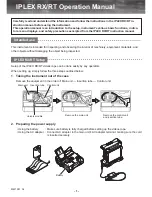
DigitalFlow™ GS868 Service Manual
29
Chapter 3. Diagnostics
3.4.2 Pipe Problems
Pipe-related problems may result either from a failure to observe the installation instructions, as described in the
Startup Guide
, or from improper programming of the meter. By far, the most common pipe problems are the following:
1. The collection of material at the transducer location(s).
Accumulated debris at the transducer location(s) will interfere with transmission of the ultrasound signals. As a
result, accurate flow rate measurements are not possible. Realignment of the flowcell or transducers often cures
such problems, and in some cases, transducers that protrude into the flow stream may be used. Refer to Chapter 1,
Installation
, of the
Startup Guide
for more details on proper installation practices.
2. Inaccurate pipe measurements.
The accuracy of the flow rate measurements is no better than the accuracy of the programmed pipe dimensions. For
a flowcell supplied by GE, the correct data will be included in the documentation. For other flowcells, measure the
pipe wall thickness and diameter with the same accuracy desired in the flow rate readings. Also, check the pipe for
dents, eccentricity, weld deformity, straightness and other factors that may cause inaccurate readings. Refer to
Chapter 2,
Initial Setup
, of the
Startup Guide
for instructions on programming the pipe data.
In addition to the actual pipe dimensions, the path length (P) and the axial dimension (L), based on the actual
transducer mounting locations, must be accurately programmed into the flowmeter. For a GE flowcell, this data
will be included with the documentation for the system. If the transducers are mounted onto an existing pipe, these
dimensions must be precisely measured. See Appendix D,
Measuring P and L Dimensions
, of the
Startup Guide
for
a thorough discussion of this topic.
3.4.3 Transducer Problems
Ultrasonic transducers are rugged, reliable devices. However, they are subject to physical damage from mishandling
and chemical attack. The most common transducer problems are listed below:
1.
LEAKS:
Leaks may occur around the transducer and/or the flowcell fittings. Repair such leaks immediately. If the
leaking gas is corrosive, carefully check the transducer and cables for damage, after the leak has been repaired.
2.
CORROSION DAMAGE:
If the transducer material was not properly chosen for the intended application, the
transducers may suffer corrosion damage. The damage usually occurs either at the electrical connector or on the
transducer surface. If corrosion is suspected, remove the transducer from the flowcell and carefully inspect the
electrical connector and the transducer surface for roughness and/or pitting. Any transducer damaged in this
manner must be replaced. Contact the factory for information on transducers in materials suitable for the
application.
3.
INTERNAL DAMAGE:
An ultrasonic transducer consists of a ceramic crystal bonded to the transducer case. The bond
between the crystal and the case or the crystal itself may be damaged by extreme mechanical shock and/or
temperature extremes. Also, the internal wiring can be corroded or shorted if contaminants enter the transducer
housing.
4.
PHYSICAL DAMAGE:
Transducers may be physically damaged by dropping them onto a hard surface or striking them
against another object. The transducer connector is the most fragile part and is the one most subject to damage.
Minor damage may be repaired by carefully bending the connector back into shape. If the connector cannot be
repaired, the transducers must be replaced.
Note:
Transducers must be replaced in pairs. Refer to Chapter 2,
Initial Setup
, of the
Startup Guide
to program the
replacement transducer data into the meter.
If the instructions in this section fail to resolve the problem, contact the factory for assistance.
Summary of Contents for DigitalFlow GS868
Page 2: ......
Page 4: ...ii no content intended for this page...
Page 10: ...Contents viii DigitalFlow GS868 Service Manual...
Page 26: ...Chapter 1 Calibration DigitalFlow GS868 Service Manual 16...
Page 40: ...Chapter 3 Diagnostics 30 DigitalFlow GS868 Service Manual no content intended for this page...
Page 68: ...Warranty 58 DigitalFlow GS868 Service Manual no content intended for this page...
Page 72: ......
Page 73: ......
















































